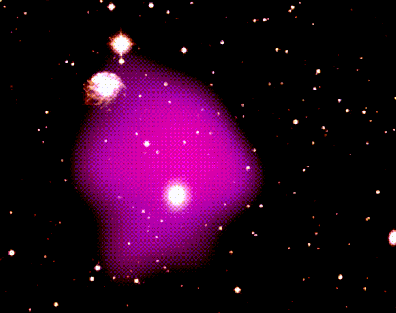A Primer on Dark Matter

FIGURE: Superposed on
an optical picture of a group of galaxies is an
X-ray image taken by
ROSAT.
The image shows confined hot gas (which produces X-rays)
highlighted in
false red color. The presence of this confined gas
indicates that the gravity
exerted in groups and clusters of galaxies is larger than that expected from the
observed galaxies.
There are many reasons to believe that the universe is full of "dark matter",
matter that influences the evolution of the universe gravitationally, but is
not seen directly
in our present observations. The adjacent image exhibits one recent piece of
evidence for undetected
matter: the hot gas seen in the X-ray spectrum would have
dispersed if it were held in place only the by gravity of the mass that is
producing light in this image (the so-called "luminous mass").
The nature of this dark matter, and the
associated "missing mass problem", is one of the
fundamental cosmological issues of
modern astrophysics. The following is a brief tutorial on this
issue extracted from an informal email message:
- If inflation is correct then, since luminous stars and galaxies
only contribute 0.5% of the closure density, then 99% of the
Universe is in the form of dark matter and this, no doubt, must
be a particle. There are always candidates. Neutrinoes have never
been a viable candidate for a fairly simple reason. Neutrinoes
are relativistic (e.g. hot dark matter) and therefore they erase
fluctuations on small scales (they free stream and fill the horizon
in the early universe). Thus the only fluctuations that can still
exist in a neutrino dominated Universe are on a very large scale.
These will cool and form structure but only on largescales, you
will never form galaxies in this manner.
- On smaller scales, such as galaxies and clusters of galaxies, dynamical
estimates of the mass, based on either rotation curves of galaxies or
velocity dispersions of galaxies indicate that 90% (not 99% which
is another order of magnitude) of the total mass is sub-lumnous.
This isn't so bad as it implies the mass density of the Universe is
10% of the closure density. In this case, the sub-luminous mass could
very well be normal (baryonic) and be locked up in stellar remnants
(white dwarfs, neutron stars, black holes) or just in very dim stars called
"Brown Dwarfs".
There is recent evidence for possible observation of one of these very dim
Brown Dwarfs.
Some of this is being tested with the microlensing experiments currently
underway in australia (you can actually find some of what I am talking
about at http://zebu.uoregon.edu/cosmo.html) and there are positive
detections but the selection function is unknown at present and so the
lensing population is also unknown.
- Although inflation demands that the Universe has a density equal
to its critical density (and inflation is necessary to solve the horizon
problem) there has never been any observational evidence to support
this high of mass density. Most dynamical studies suggest values of
10-20% of closure density. These studies are based on large scale
deviations from hubble expansion velocities (so called peculiar
velocities).
- Large scale structure (e.g. the distribution of galaxies) is very
hard to understand, particularly in light of the relatively smooth
microwave background as measured by the COBE satellite. There is
way too much power on large scales. One way to accomodate this is
to go to a mixed dark matter model in which you have some hot dark matter
(for the large scale power) and some cold dark matter (wimps, axions,
photinos, supersymmetric particles, etc) to act as a seed for galaxy
formation. None of those models, however, fit the data using the
critical density. The best models to date (you can see a diagram in
the http document referenced above) suggest mixed dark matter and an
overall cosmological mass density of 20-30% of closure. Hence, to
retain inflation, with its inescapable prediction that the Universe
must be flat, requires re-invoking Einstein's cosmological constant -
meaning the universe has vacuum energy (negative pressure) and is
currently accelerating. This makes our cosmology complicated but much
data is pointing this way.
- Finally, there have been speculative papers that if the dark matter
is really something toally new and mysterious then maybe it communicates
with itself over some long range force (either attractive or repulsive).
An intriguing idea as that would mess up all the comoslogical dynamics -
but given the really surprising nature of the galaxy distribution -
something clearly very funny is going on.
- Supernova 1987a neutrino time of flight studies as well as the Solar
Neutrino experiment are consistent with the neutrino having a mass, but
a very small mass, not one that can cosmologically dominate. As for
seeing particles in other ways - well since the SSC won't be built we
can not do an accelerator test for seeing supersymmetric particles which
would only be created at very high energy (e.g. the early universe) -
so there remain many viable potential particles that are consistent with
the Standard MOdel of particles (e.g. 3 generations of neutrinoes,
6 quarks) and which would remain unnoticed in any accelerator experiments.
Source: http://zebu.uoregon.edu/text/darkmatter.txt
Here are links to two experimental searches for Dark Matter candidates:
 Home
(Use the "Back" button on the browser to return.)
Home
(Use the "Back" button on the browser to return.)
Mike Guidry:
guidry@utk.edu
http://csep1.phy.ornl.g
ov/guidry/mwg-root.html

 Home
(Use the "Back" button on the browser to return.)
Home
(Use the "Back" button on the browser to return.)